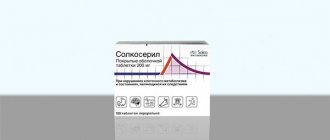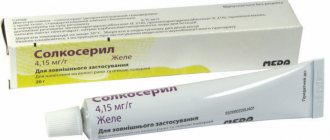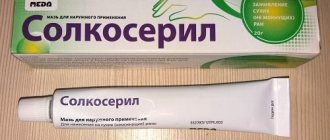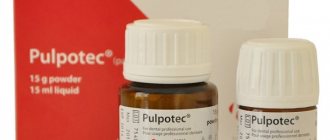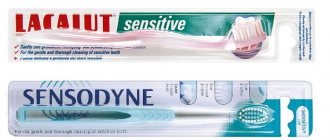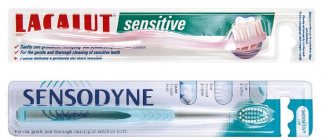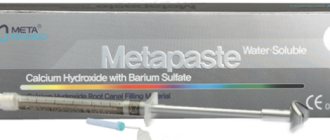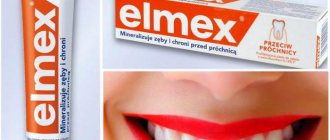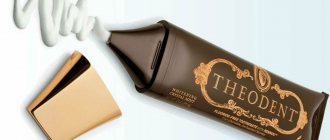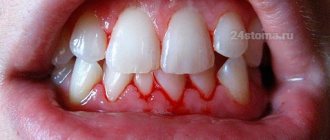pharmachologic effect
Combined preparation for local use, stimulator of tissue regeneration.
The drug is a chemically and biologically standardized deproteinized dialysate obtained from the blood of healthy dairy calves using the ultrafiltration method. Contains a wide range of natural low-molecular compounds weighing up to 5000 Daltons: glycolipids, nucleosides and nucleotides, amino acids, oligopeptides, trace elements, electrolytes, intermediate products of carbohydrate and fat metabolism. Activates the transport of oxygen and nutrients at the cellular level, increases oxygen consumption by the cell, stimulates ATP synthesis, enhances the proliferation of reversibly damaged cells, especially under hypoxic conditions, thereby accelerating wound healing processes. Stimulates angiogenesis, promotes revascularization of ischemic tissue, as well as creating conditions favorable for collagen synthesis and the growth of fresh granulation tissue, accelerates re-epithelialization and wound closure. The drug also has membrane-stabilizing and cytoprotective effects.
Polidocanol 600 - local anesthetic; acts in the area of peripheral nerve endings, causing their reversible blocking. It has a quick and long-lasting local anesthetic effect. After applying the paste to the oral mucosa, the pain stops within 2-5 minutes; pain relief lasts for 3-5 hours.
Solcoseryl dental adhesive paste forms a protective healing layer on the affected area of the oral mucosa and protects it from mechanical and chemical damage for 3-5 hours, performing the function of a medicinal bandage.
Analogues of Solcoseryl gel
In medical practice, a dosage form of the drug in the form of a gel, which is lighter in texture, is widely used. There are cheap analogues of Solcoseryl gel and more expensive ones, which include:
- Contratubeks – has fibrinolytic, anti-inflammatory, keratolytic effects. Due to the active components, the proliferation of connective tissue, swelling, and pain are blocked. Keloid scars and skin changes after acne or furunculosis are softened.
Early use of Contratubex eliminates the formation of scar tissue, and keloid scars become less noticeable.
Directions for use and dosage
The drug is intended for local use on the oral mucosa.
The affected surface of the mucous membrane must first be dried with a cotton or gauze swab. Apply a strip of paste about 0.5 cm long, without rubbing, onto the mucous membrane in a thin layer with your finger or using a cotton swab, and then lightly moisten the applied paste with water. The procedure is repeated 3-5 times a day after meals and before bedtime. Treatment is carried out until symptoms disappear.
Solcoseryl dental adhesive paste forms a protective therapeutic layer on the affected area of the oral mucosa and protects it from mechanical and chemical damage for 3-5 hours. When applying the paste to undried mucosa, the duration of the therapeutic effect can be reduced.
When treating bedsores from removable dentures, apply the paste to a dry denture and moisten with water.
The recommended course dose of the drug is 1 tube (5 g).
Solcoseryl dental adhesive paste 5g
Description
Light beige, granular, easily distributed homogeneous mass with the smell of peppermint.
Release form
5 g in aluminum tubes. The tube, along with instructions for use, is placed in a cardboard box.
special instructions
You should not put Solcoseryl dental adhesive paste into the wound cavity formed as a result of the removal of molars, wisdom teeth, as well as apicotomy (resection of the apex of the tooth), if the edges of the tooth socket are tightened with subsequent sutures. Solcoseryl dental adhesive paste does not contain anti-infective components. In case of acute infection of the affected area of the oral mucosa, which is subject to treatment with this drug, it is necessary to carry out preliminary medical treatment/treatment of the affected area aimed at eliminating the symptoms of inflammation.
pharmachologic effect
Solcoseryl is a deproteinized hemodialysate that contains a significant amount of low-molecular components of cells and blood serum of calves (dialysis/ultrafiltration, maximum molecular weight 5000 Da), the chemical and pharmacological properties of which are only partially described to date. A study of the drug on various cell and tissue cultures, organs, as well as animals showed that Solcoseryl: maintains and/or restores aerobic energy metabolism, as well as oxidative phosphorylation processes in cells deprived of sufficient nutrients, thereby maintaining and/or restoring supply of high-energy phosphates, increases oxygen uptake (in vitro), as well as glucose transport in hypoxic and metabolically depleted tissues and cells, improves repair and regeneration processes in damaged tissues and/or tissues deprived of sufficient nutrients, prevents and/or reduces secondary degeneration and pathological changes in reversibly damaged cellular systems, enhances collagen synthesis in in vitro models, and also stimulates cell proliferation and migration in vitro. Consequently, Solcoseryl dental adhesive paste protects tissues prone to hypoxia and/or substrate depletion. It stimulates the restoration of functions in reversibly damaged tissue, and also accelerates the healing of lesions and improves the quality of this process. Macrogol-9-lauryl ether (Polidocanol 600), a topical anesthetic, reversibly blocks peripheral nerve endings. Due to its high wetting ability, the analgesic effect occurs within 1-3 minutes after application. Due to the adhesive ability of the paste, this effect can last from 1 to 5 hours, depending on the location of the lesion and salivation. After swelling under the influence of saliva and wound secretions, the paste base, consisting of pectin, gelatin, sodium carboxymethylcellulose, liquid paraffin and polyethylene, forms an adhesive and elastic protective film on the wound.
Indications for use
Solcoseryl dental adhesive paste is used for local acceleration of healing, pain relief and protection of the wound surface in the following diseases and conditions: Treatment of painful and inflammatory processes of the oral mucosa, gums and lips (aphthae, labial herpes, gingivitis, periodontitis, stomatitis) Treatment of lesions caused by pressure of dentures on tissue (bedsores) Treatment of complications associated with the appearance of wisdom teeth Treatment of wounds after removal of tartar, curettage, periodontal surgery, tooth extraction and installation of immediate dentures Alveolitis.
Directions for use and doses
The drug is intended for local use in the oral mucosa. The affected surface of the mucous membrane must first be dried with a cotton or gauze swab. Apply a strip of paste about 0.5 cm long, without rubbing, onto the mucous membrane in a thin layer using a finger or a cotton swab, and then lightly moisten the applied paste with water. The procedure is repeated 3-5 times a day after meals and before bedtime. Treatment is carried out until symptoms disappear. Solcoseryl dental adhesive paste forms a protective healing layer on the affected area of the oral mucosa and protects it from mechanical and chemical damage for 3-5 hours. When applying the paste to undried mucous membranes, the duration of the therapeutic effect may be reduced. When treating bedsores from removable dentures, apply the paste to a dry denture and moisten with water. The recommended course dose of the drug is 1 tube (5 g). Special categories of patients Children The effectiveness and safety of the drug in children aged 2-5 years have not been sufficiently studied. There are no restrictions regarding the use of the drug in children over 2 years of age. There are no restrictions regarding the use of the drug in elderly patients.
Use during pregnancy and lactation
Animal studies have shown no risk to the fetus, but there have been no controlled studies in pregnant women. Caution should be exercised when used during pregnancy. There are no objections to the use of Solcoseryl dental adhesive paste during lactation.
Interaction with other drugs
To date, there have been no cases of interaction between Solcoseryl dental adhesive paste and other drugs. When simultaneously prescribing Solcoseryl dental adhesive paste and other drugs in the form of rinses, the paste should be applied after using these drugs.
Contraindications
individual sensitivity to any of the components of the drug (to preservatives - esters of parahydroxybenzoic acid (E216 and E218)), including free parahydroxybenzoic acid (E 210), the presence of a residual amount of which is due to the peculiarities of the technological process during the production of the drug. Infants and children under two years of age: Peppermint oil and levomenthol may cause spasm of the larynx, leading to serious breathing problems.
Compound
per 1 g Active ingredients: Solcoseryl (deproteinized dialysate from the blood of dairy calves), in terms of dry matter - 2.125 mg; polidocanol - 10,000 mg. Excipients: sodium carboxymethylcellulose, methyl parahydroxybenzoate (E 218), propyl parahydroxybenzoate (E 216), peppermint oil, menthol. Paste base: sodium carboxymethylcellulose, gelatin, pectin, polyethylene, liquid paraffin.
Overdose
There is no information on the effects of an overdose of the drug.
Side effect
change in taste sensations: allergic reactions (local swelling) are possible, if they occur, you must stop using the drug and consult a doctor. In rare cases (less than 0.01%), allergic reactions, in particular shortness of breath, may develop. In such cases, you should stop using the drug. May cause laryngospasm in infants and children under 2 years of age.
Storage conditions
Store at a temperature not exceeding 25°C. Keep out of the reach of children! The granular-dry consistency of the paste ensures its optimal adhesive properties and is not a sign of deterioration in the quality of the drug. When opening the tube, oil may be released, which is also not a sign of deterioration in the quality of the drug.
Buy Solcoseryl dental adhesive paste 5g in a pharmacy
Price for Solcoseryl dental adhesive paste 5g
Instructions for use for Solcoseryl dental adhesive paste 5g
Solcoseryl or Actovegin - which is better, what is the difference
Manufacturer: TAKEDA GMBH (Austria)
Release form: injection solution, tablets, cream, gel, ointment for external use
Active ingredient: deproteinized hemoderivative from calf blood
Both drugs have an equivalent mechanism of action and therapeutic effect, since they have the same active substance. Solcoseryl and its analogue Actovegin stimulate metabolic processes, tissue regeneration, and improve trophism. Despite their similarity, there is a difference between them that can be traced:
- in cost - Solcoseryl is cheaper;
- in release form - Actovegin is produced in tablets, but Solcoseryl is not.
Medicines work well and are used for healing wound surfaces and ulcerative processes of various etiologies. Atovegin will be the best, since it has a gentler effect on the body and is allowed to be used by pregnant women.
Analogs of Solcoseryl eye gel
In ophthalmic practice, cheaper analogues of Solcoseryl in the form of an eye gel, represented by the following preparations, are widely used:
- Korneregel – has regenerative and anti-inflammatory properties. A special feature of this dosage form for the eyes is its viscosity, due to which Korneregel does not penetrate the eyeball, but remains on the damaged area and is not washed off with water.
- Dexpanthenol – has a regenerating, anti-inflammatory and metabolic effect. The analogue has the ability to replenish pantothenic acid deficiency in the area of damaged skin or mucous membrane.
- Hyphenosis - has a protective effect on the corneal area, moisturizing and protecting it in the presence of reduced secretion of tear fluid. The analogue has a high degree of viscosity, which leads to the restoration and stabilization of the optical properties of the tear film.
- Taufon - has a stimulating effect on reparative and regenerative processes in diseases of a dystrophic nature or accompanied by metabolic disorders in the eye tissues.
A large selection of Solcoseryl eye gel analogues allows you to successfully treat various ophthalmological diseases and injuries.
Solcoseryl or Levomekol – which is better?
Manufacturer: JSC NIZHFARM (Russia)
Release form: ointment for external use
Active ingredient: dioxomethyltetrahydropyrimidine, chloramphenicol
Both drugs are widely used in practical medicine, especially in surgery for the treatment of complicated and uncomplicated wounds of various origins. Levomekol ointment will be the best for purulent wounds in the inflammation phase (boils, bedsores, purulent pimples).
Under the influence of the analogue, liquid secretion is eliminated from the wound surface and tissue is rapidly regenerated. For scratches and 1st-2nd degree burns, it is better to use Solcoseryl.
Analogues of Solcoseryl injections (ampoules)
The dosage form of Solcoseryl for injection also has a number of analogues with equivalent therapeutic effect. What can replace Solcoseryl injections with, what analogues? The following medications can be included in this list:
- Actovegin - has an active effect on metabolic processes in the body. This substitute for Solcoseryl in ampoules stimulates oxidative metabolism, which leads to an increase in the energy potential of cellular structures and accelerated wound healing.
- Glekomen - has a restorative effect on the corneal epithelium and protects it from the negative influence of external irritants. The analogue stimulates proliferation, that is, the growth of the corneal endothelium and the normalization of water-salt metabolism of its stroma in case of damage and keratopathy.
The use of Solcoseryl analogues in injections for the treatment of diseases and wounds of various locations gives good results and high therapeutic efficacy.
